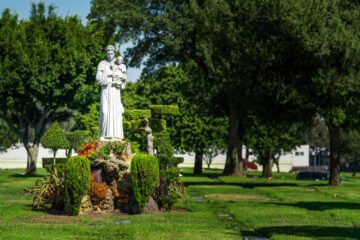Ash Wednesday & Ember Days: Significance and Modern Observance in Catholicism
“`html
The Catholic Church is a tapestry of rich traditions, many of which have evolved over centuries. Among these enduring practices are the Ember Days, periods of fasting and prayer that occur four times a year, marking the changing seasons. While Ember Days have somewhat faded from the official liturgical calendar following the reforms of the Second Vatican Council, they remain a valuable part of the Church’s heritage and offer a meaningful way for individuals to connect with ancient spiritual practices.
What Are Ember Days?
Ember Days are sets of three days—Wednesday, Friday, and Saturday—that occur four times a year, traditionally coinciding with the beginning of each season:
- Spring Ember Days: After Ash Wednesday
- Summer Ember Days: After Pentecost Sunday
- Autumn Ember Days: After the Feast of the Holy Cross (September 14)
- Winter Ember Days: After the Feast of St. Lucy (December 13)
These days were historically dedicated to fasting, abstinence, and prayer, serving as opportunities for the faithful to thank God for the gifts of creation and to prepare spiritually for the coming season.
Historical Context
The practice of observing Ember Days dates back to the early Church, with evidence suggesting they were already in practice in the 4th century. Their origins are often linked to the early Church’s focus on prayer and penance for the forgiveness of sins. The term “Ember” itself is derived from the Latin “Quatuor Tempora,” meaning “four times,” reflecting the four periods of the year when these days were observed. These days were not only times for personal penance but also for ordinations, as the Church often scheduled the ordination of clergy during Ember Weeks.
A Shift in Practice
With the liturgical reforms of the Second Vatican Council in the 1960s, Ember Days were made optional. The new General Roman Calendar did not mandate their observance, allowing local bishops’ conferences to decide their relevance within their respective dioceses. Consequently, Ember Days have fallen off the official Catholic liturgical calendar in many regions, especially where they were not deeply rooted in local traditions. However, they continue to hold significance for some Catholics, particularly those who appreciate the spiritual value of these traditional practices.
The Importance of Humility and Discretion in Fasting
While fasting and abstinence are valuable spiritual disciplines in the Catholic tradition, the Church emphasizes the importance of performing these acts with humility and discretion. Drawing from the words of Jesus in the Gospel of Matthew:
“When you fast, do not look somber as the hypocrites do, for they disfigure their faces to show others they are fasting… But when you fast, put oil on your head and wash your face, so that it will not be obvious to others that you are fasting, but only to your Father.”
— Matthew 6:16-18
This passage underscores that fasting should be a personal commitment between the individual and God, not a means to gain public recognition. Announcing one’s fasting can diminish its spiritual value and lead to pride, counteracting the humility that fasting is meant to cultivate.
Modern Observance of Ember Days
While not universally observed today, Ember Days offer a meaningful way for individuals to reconnect with traditional practices:
- Personal Fasting: Individuals can choose to fast or abstain from certain foods during these days.
- Prayer and Reflection: Devote time to prayer, Scripture reading, and meditation on the themes related to each season.
- Almsgiving: Acts of charity align with the spirit of penance and generosity, offering a practical way to express gratitude and love for God’s gifts.
By observing Ember Days privately, the faithful can adhere to the teaching of performing spiritual acts without seeking external validation, allowing for a more genuine and meaningful connection with God.
Upcoming Ember Days
For those interested in observing Ember Days, here are the dates for the upcoming years:
2024
- Spring Ember Days
- Wednesday, February 21
- Friday, February 23
- Saturday, February 24
- Summer Ember Days
- Wednesday, May 22
- Friday, May 24
- Saturday, May 25
- Autumn Ember Days
- Wednesday, September 18
- Friday, September 20
- Saturday, September 21
- Winter Ember Days
- Wednesday, December 18
- Friday, December 20
- Saturday, December 21
2025
- Spring Ember Days
- Wednesday, March 5
- Friday, March 7
- Saturday, March 8
- Summer Ember Days
- Wednesday, June 11
- Friday, June 13
- Saturday, June 14
- Autumn Ember Days
- Wednesday, September 17
- Friday, September 19
- Saturday, September 20
- Winter Ember Days
- Wednesday, December 17
- Friday, December 19
- Saturday, December 20
Please note that these dates are based on the traditional calendar and may vary depending on local liturgical practices.
How to Observe Ember Days Today
While the formal observance of Ember Days has shifted, there are many ways to embrace their spirit in a modern context:
- Fasting and Abstinence: Traditionally, fasting involves eating one full meal with two smaller meals that do not equal a full meal. Abstinence typically means refraining from meat. Individuals can choose to adopt these practices, even partially, during Ember Days.
- Private Devotion: Keep your practices between you and God to maintain humility, focusing on the spiritual depth of your acts of prayer, fasting, and almsgiving rather than seeking external recognition.
- Spiritual Reading: Use the time to read Scripture or other spiritual works that relate to the themes of each season.
- Community Service: Engaging in acts of charity or volunteer work can be a powerful way to embody the spirit of Ember Days, expressing gratitude and love for God’s gifts through concrete actions.
Ash Wednesday: A Time of Reflection and Renewal
Ash Wednesday marks the beginning of Lent, a 40-day period (excluding Sundays) leading up to Easter Sunday. Lent is a time for Catholics to prepare for the celebration of the Resurrection of Jesus Christ through prayer, fasting, and almsgiving. Ash Wednesday sets the tone for this solemn season by reminding the faithful of their mortality and the need for repentance.
Biblical Foundations
The use of ashes as a symbol of penance and mourning has deep roots in biblical tradition. In the Old Testament, figures like Job and Daniel used ashes to express sorrow for their sins:
- Job 42:6: “Therefore I despise myself and repent in dust and ashes.”
- Daniel 9:3: “So I turned to the Lord God and pleaded with him in prayer and petition, in fasting, and in sackcloth and ashes.”
These references highlight the historical significance of ashes as a physical manifestation of inner repentance.
The Ritual of Receiving Ashes
On Ash Wednesday, Catholics attend Mass or a special service where ashes are blessed and distributed. The ashes are typically made by burning the palm branches from the previous year’s Palm Sunday. This cyclical use of palms and ashes symbolizes the continuity of faith and the perpetual need for repentance. It is a reminder that we are all called to renewal and transformation.
The Imposition of Ashes
During the service, the priest or minister marks the forehead of each person with ashes in the shape of a cross. While doing so, they recite one of two phrases:
- “Remember that you are dust, and to dust you shall return.” (Genesis 3:19)
- “Repent, and believe in the Gospel.” (Mark 1:15)
These words serve as a poignant reminder of human mortality and the call to conversion, encouraging us to examine our lives and seek reconciliation with God.
The Meaning Behind the Ashes
The ashes symbolize several key themes in Catholic spirituality:
- Mortality: A reminder that earthly life is temporary, prompting us to live with purpose and focus on what truly matters.
- Repentance: An outward sign of an inner desire to turn away from sin, seeking forgiveness and striving to live a more virtuous life.
- Humility: Acknowledging one’s imperfections and dependence on God’s mercy, fostering a spirit of humility and openness to God’s grace.
By bearing the ashes on their foreheads, Catholics publicly profess their faith and their commitment to spiritual growth, acknowledging their need for God’s mercy and grace.
Fasting and Abstinence
Ash Wednesday is also a day of fasting and abstinence:
- Fasting: Catholics aged 18 to 59 are encouraged to eat only one full meal, with two smaller meals that together do not equal a full meal. This practice symbolizes self-discipline and a willingness to sacrifice for spiritual growth.
- Abstinence: All Catholics aged 14 and older abstain from eating meat. This practice serves as a reminder of the need for sacrifice and solidarity with those who are less fortunate.
These practices, performed with humility and discretion, are meant to foster self-discipline and solidarity with the less fortunate, aligning with the spirit of repentance and renewal that characterizes Lent.
Continuing the Journey: Lent and Beyond
While Ash Wednesday is a significant starting point, the themes of repentance and renewal continue throughout Lent. Catholics are encouraged to engage in practices that help them deepen their relationship with God, strengthen their resolve to live virtuous lives, and prepare for the joy of Easter:
- Prayer: Deepening their relationship with God through daily prayer and reflection.
- Fasting: Sacrificing personal comforts and desires to focus on spiritual needs.
- Almsgiving: Sharing resources with those in need as a tangible expression of compassion and love for God’s children.
These practices aim to prepare the faithful for the joy of Easter and the celebration of Christ’s resurrection, transforming hearts and lives in preparation for the ultimate victory of love over sin and death.
Ash Wednesday in the Modern World
In today’s fast-paced society, Ash Wednesday remains a powerful reminder of spiritual priorities. Many churches offer “Ashes to Go,” where ministers impose ashes on people in public places like train stations or street corners. This adaptation makes the ritual accessible to those who may not be able to attend a traditional service, bringing the message of repentance and renewal into the everyday lives of individuals.
Conclusion
Ember Days and Ash Wednesday both offer profound opportunities for spiritual renewal and growth in Catholic tradition. Ember Days invite discreet fasting and prayer for seasonal reflection, allowing individuals to connect with ancient practices and deepen their relationship with God. Ash Wednesday marks the beginning of Lent, focusing on repentance and recommitment through fasting, prayer, and acts of charity. Both practices encourage humility and a deeper relationship with God, enriching one’s spiritual journey in accordance with Jesus’ teachings. By embracing these ancient traditions, Catholics can find pathways to deeper faith and a more meaningful life.
“`




